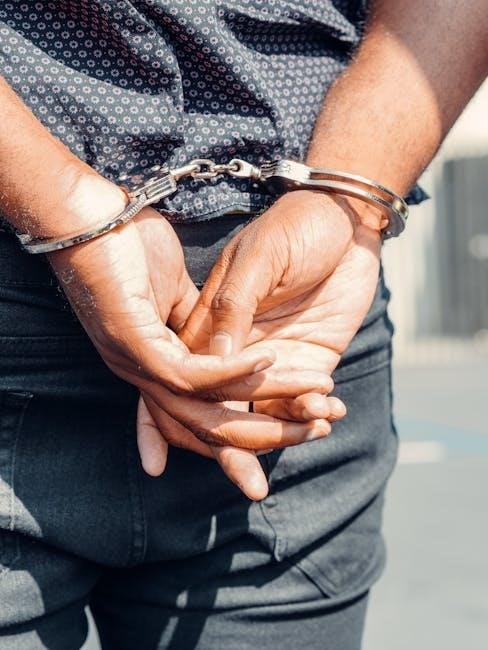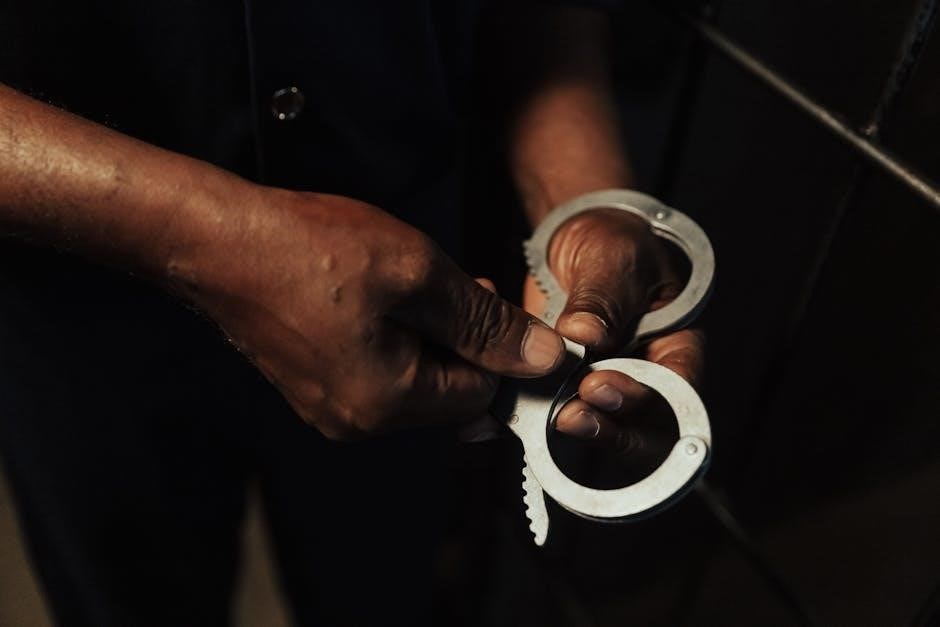The American criminal justice system is a complex framework addressing crime and justice. It encompasses law enforcement, courts, and corrections. Studying it reveals its evolution, challenges, and the need for reform, offering insights into societal impacts and the role of psychology in understanding criminal behavior.
1.1 Overview of the Criminal Justice System
The U.S. criminal justice system is a network of institutions that enforce laws, adjudicate crimes, and rehabilitate offenders. It includes law enforcement, courts, and corrections, working together to maintain public safety and justice. The system aims to protect rights, deter crime, and rehabilitate offenders, while addressing challenges like racial disparities and technological advancements in crime prevention and prosecution.
1.2 Key Concepts and Terminology
Key concepts include criminal justice processes like investigation, adjudication, and rehabilitation. Terminology such as “probation,” “parole,” and “recidivism” are essential. Understanding terms like “exculpatory evidence” and “racial disparities” highlights systemic challenges. These concepts form the foundation for analyzing the criminal justice system’s structure, functions, and reforms, providing a framework for discussing its complexities and evolution over time.
1.3 Importance of Studying Criminal Justice
Studying criminal justice is crucial for understanding crime causes, justice mechanisms, and policy impacts. It prepares professionals to address ethical dilemmas, promote fairness, and enhance public safety. Analyzing the system’s strengths and weaknesses fosters informed reform and societal progress, ensuring equitable treatment for all individuals within the legal framework.
The Structure of the Criminal Justice System
The criminal justice system comprises law enforcement, courts, and corrections, working to prevent crime, enforce laws, and deliver justice through structured processes and policies.
2.1 Law Enforcement Agencies
Law enforcement agencies, such as police departments and the FBI, play a crucial role in preventing and investigating crimes. They enforce laws, maintain public order, and gather evidence to support prosecutions. Their responsibilities include responding to emergencies, patrolling neighborhoods, and collaborating with other agencies to address complex challenges like cybercrime and organized crime effectively.
2.2 Courts and the Judicial Process
Courts are central to the judicial process, adjudicating criminal cases and ensuring justice. They determine guilt, interpret laws, and impose sentences. The process includes arraignments, trials, and sentencing, with prosecutors presenting evidence. Courts rely on due process to protect rights, ensuring fairness. Juries or judges decide outcomes, reflecting societal values and legal standards in criminal justice.
2.3 Corrections and Rehabilitation
Corrections and rehabilitation focus on punishing offenders and preparing them for society; Incarceration, probation, and parole are common methods. Rehabilitation programs, including education and mental health services, aim to reduce recidivism. The system balances punishment with rehabilitation, addressing offender needs to promote public safety and successful reintegration into communities.

Historical Context of Criminal Justice in America
The criminal justice system in America has evolved from colonial practices, influenced by English law. Over time, it has adapted to societal changes, addressing crime and justice through shifting policies and practices.
3.1 Evolution of Criminal Justice Policies
Criminal justice policies in America have evolved significantly, shaped by landmark cases and legislative reforms. Early practices focused on punishment, while modern approaches emphasize rehabilitation and restorative justice. The War on Drugs and mandatory sentencing laws marked a punitive era, while recent reforms aim to address racial disparities and reduce mass incarceration, promoting equitable justice.
3.2 Landmark Cases and Their Impact
Landmark cases like Miranda v. Arizona and Brown v. Mississippi have profoundly shaped criminal justice. These rulings established protections against coerced confessions, ensured due process, and reformed police practices. They underscored the importance of constitutional rights, influencing modern law enforcement and trial procedures to promote fairness and accountability in the justice system.
Challenges in the Criminal Justice System
The criminal justice system faces racial disparities, technological crimes, and victim support issues. Mental health concerns and recidivism rates further complicate efforts to achieve fairness and rehabilitation.
4.1 Racial Disparities and Bias
Racial disparities persist in the criminal justice system, with marginalized communities facing disproportionate arrests, sentencing, and incarceration. Bias in law enforcement and judicial processes contributes to systemic inequality. FBI statistics reveal overrepresentation of minorities in crime reports, highlighting the need for reforms to address these deeply rooted issues and ensure equitable justice for all individuals.
4.2 The Role of Technology in Modern Crime
Technology has transformed modern crime, enabling cybercriminal activities like hacking and data breaches. Digital forensics aids investigations, but criminals exploit encryption and anonymity. The rise of cybercrime challenges law enforcement, requiring advanced tools to combat threats. Meanwhile, surveillance and AI tools raise ethical concerns, balancing public safety with privacy rights in the digital age.
4.3 Victim Experience and Support
Victims of crime often face systemic challenges, feeling let down by the justice system. Advocacy groups and support services aim to address their needs, ensuring access to mental health resources and legal guidance. The integration of victim-centered approaches in criminal justice reforms is crucial for fostering trust and recovery, emphasizing the importance of prioritizing victim well-being.
Reforms and Future Directions
Criminal justice reforms focus on addressing systemic inequities and improving outcomes. Legislative changes aim to reduce recidivism and promote rehabilitation. Community-based programs are prioritized to support offenders and victims, fostering a more equitable and effective justice system.
5.1 Policy Changes and Legislative Reforms
Recent legislative reforms aim to address systemic inequities and improve criminal justice outcomes. Bills focus on reducing recidivism, enhancing rehabilitation programs, and promoting fairness. Measures include bail reform, sentencing changes, and expanded support for reintegration. These changes reflect a growing emphasis on rehabilitation over punishment, addressing racial disparities, and ensuring accountability while fostering community safety and justice.
5.2 Community-Based Alternatives to Incarceration
Community-based alternatives aim to reduce incarceration rates by focusing on rehabilitation. Programs include probation, electronic monitoring, and treatment for mental health or substance abuse. These approaches address root causes of crime, reduce recidivism, and promote reintegration into society. They also alleviate prison overcrowding, offering cost-effective solutions while maintaining public safety and fostering community well-being.

The Role of Psychology and Criminology
Psychology and criminology play pivotal roles in understanding criminal behavior, mental health, and crime patterns. They provide insights into motivations, prevention strategies, and rehabilitation methods, aiding justice system improvements.
6.1 Understanding Criminal Behavior
Understanding criminal behavior involves analyzing psychological, social, and environmental factors. Psychology helps identify motivations, while criminology examines crime patterns and societal influences. Insights from these fields aid in developing prevention strategies, rehabilitation programs, and policies to address root causes of crime, ultimately improving justice system effectiveness and reducing recidivism rates.
6.2 Mental Health in the Criminal Justice System
Mental health is a critical issue within the criminal justice system, as many offenders struggle with psychological disorders. Integration of mental health services in correctional facilities and courts has become essential. Programs like MI (Mental Health Integration) address behavioral health issues, aiming to reduce recidivism and improve rehabilitation outcomes, while advocating for systemic reforms to better support mentally ill individuals.
The Impact of Crime on Society
Crime imposes significant economic and social costs, fostering fear and community breakdown. Media influence shapes public perception, often amplifying concerns and demand for justice system reform.
7.1 Economic and Social Consequences
Crime burdens society economically through costs like law enforcement, healthcare, and lost productivity. Socially, it erodes community trust, increases fear, and perpetuates cycles of poverty and discrimination, impacting vulnerable populations disproportionately.
7.2 Public Perception and Media Influence
Public perception of crime is heavily shaped by media portrayal, often amplifying fear and misconceptions. Crime shows and news coverage skew views, influencing policy and societal attitudes. Media bias can perpetuate racial disparities and reinforce punitive measures, despite evidence showing systemic issues drive crime rates and justice outcomes;
Juvenile Justice and Rehabilitation
The juvenile justice system focuses on rehabilitation over punishment, utilizing specialized programs to address youth offenders’ unique needs and reduce recidivism rates in the criminal justice system.
8.1 The Juvenile Justice System
The juvenile justice system prioritizes rehabilitation, focusing on addressing the unique needs of youth offenders through counseling, education, and community programs to reduce recidivism and promote positive outcomes.
8.2 Rehabilitation Programs and Recidivism
Rehabilitation programs aim to reduce recidivism by addressing mental health, education, and employment needs. Community-based alternatives, like probation and counseling, help individuals reintegrate into society. These programs focus on long-term behavior change, reducing crime rates and fostering safer communities through structured support and resources.

Cybercrime and Digital Forensics
Cybercrime and digital forensics are critical in modern criminal justice, addressing online offenses like hacking and fraud. Forensic techniques help investigate and prosecute cybercriminal activities effectively.
9.1 The Rise of Cybercriminal Activity
Cybercriminal activity has surged, targeting critical infrastructure, schools, and hospitals globally. Sophisticated attacks exploit technological vulnerabilities, with criminals leveraging encryption and darknet tools for anonymity. The FBI recently disrupted a major group, highlighting the urgent need for advanced digital forensics to combat these evolving threats and protect society from cybercrime’s growing impact.
9.2 Investigative Techniques in Cybercrime
Advanced investigative techniques in cybercrime include digital forensics, IP tracking, and network analysis. Law enforcement agencies like the FBI use encryption-breaking tools and collaborate with international partners to infiltrate criminal groups. These methods help gather evidence, identify patterns, and disrupt cybercriminal networks, ensuring justice and protecting society from evolving digital threats.

International Perspectives on Criminal Justice
Global criminal justice systems vary widely, with differing approaches to punishment, rehabilitation, and crime prevention. International cooperation addresses cross-border crime, while comparative studies reveal unique strategies and challenges.
10.1 Comparative Analysis of Criminal Justice Systems
Comparative analysis reveals diverse approaches to criminal justice globally. The U.S. emphasizes punishment, while systems like Norway focus on rehabilitation. Differences in legal frameworks, procedural safeguards, and societal values shape outcomes. International perspectives highlight varying recidivism rates, crime prevention strategies, and public trust in justice systems, offering insights into effective practices and challenges across cultures and legal traditions.
10.2 Global Crime Trends and Cooperation
Global crime trends highlight rising cybercriminal activity and organized crime impacting multiple nations. International cooperation is crucial, with agencies like the FBI targeting transnational groups extorting critical infrastructure. Collaboration enhances cross-border investigations and information sharing, addressing evolving threats. Such efforts underscore the importance of unified strategies to combat global crime effectively and protect societal interests worldwide.
The criminal justice system in America has evolved significantly, addressing racial disparities and integrating technology. Reforms focus on rehabilitation and fairness, emphasizing the need for systemic change and understanding criminal behavior to build a more equitable future.
11.1 The Future of Criminal Justice in America
The future of criminal justice in America lies in systemic reforms, embracing technology, and prioritizing rehabilitation over punishment. Addressing racial disparities, integrating mental health programs, and adopting community-based alternatives will foster a fairer system. By focusing on prevention and victims’ support, the system can evolve into a more equitable and compassionate framework for all.
11.2 Call to Action for Systemic Change
A call to action for systemic change in America’s criminal justice system demands bold reforms. Addressing racial disparities, integrating mental health support, and advancing community-based alternatives are critical. Policy changes, legislative reforms, and public advocacy must prioritize fairness, rehabilitation, and victim support. Collective action is essential to create a more just and equitable system for all Americans.
